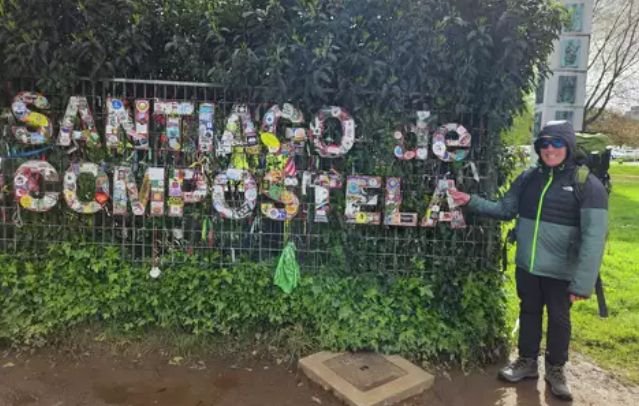He almost died of fentanyl on The Camino de Santiago S.F.’s streets. Now sober, he walked a ‘miracle’ 500-mile trek.

As Ben Campofreda set out on a more than 500-mile trek through historic Spanish villages, along rugged cliff sides and past unspoiled beaches, he felt a sense of freedom he hadn’t known for years.
Campofreda said he walked anywhere between 12 to 30 miles a day for five weeks straight — a feat that would have been remarkable for anyone, but it was almost unbelievable for him.
Just two years ago, Campofreda, 42, was living on the streets of San Francisco in the throes of a fentanyl addiction, unable to walk. His body had withered to an alarming 100 pounds and a spinal infection confined him to a wheelchair.
“Everything I do now is kind of surreal,” he said in a recent interview. “When I was in that situation (living on the streets and using fentanyl), at first it felt like I had all this freedom, but the irony is that I really had no freedom at all. I was stuck within a couple block radius of my dealer so I could feel normal everyday.”
Campofreda, who the Chronicle profiled in 2022 during the first year of his recovery, completed the Camino del Norte pilgrimage across northern Spain in April with a longtime friend and their dog, Howie.
Two brothers charged with selling fentanyl in S.F.’s Tenderloin
Authorities arrested two brothers after seizing more than 13 pounds of fentanyl and 4 pounds of methamphetamine, the San Francisco District Attorney’s Office said.
The journey back to health for Campofreda, who now lives in Portland, shows that recovery for drug users languishing on the streets of San Francisco is possible despite the many gaps and barriers in the city’s treatment system.
It’s unclear how many people come out of San Francisco’s devastating drug scene and stay in long-term recovery. Experts say it’s relatively few, but getting and staying sober is possible despite the tenacious grip of fentanyl, which can be up to 50 times more potent than heroin.
Campofreda recently celebrated two years of sobriety and is working as a camp counselor teaching wilderness skills. He’s enjoying exploring the city by bike, seeing comedy shows in the park and reconnecting with live music.
“I have a lot of moments where I’m like ‘I can’t believe that I have a normal life again,’ ” he said. “Because when you get to the point where I was at, it’s really hard to get out.”
When life gets stressful or he’s feeling down, Campofreda chooses to go for a run or do yoga instead of turning to drugs.
“Recovery happens,” said Dr. Dan Ciccarone, a UCSF professor of family and community medicine and addiction researcher. “But we shouldn’t have people getting to death’s door before they convert. We need to try harder to get younger people — people who are in early stage addiction, not late stage addiction — to see the other side. That’s where the challenge is.”
Asked what was one of the main takeaways from his story, Ben Campofreda said that more people should confront loved ones they suspect may be struggling with addiction sooner.
The root of Campofreda’s addiction dates back to when he was a young adult and a doctor prescribed him oxycodone to treat back pain. Within a couple of years, Campofreda developed a severe addiction to the pills.
He maintained a successful career first as a snowboarding instructor and then as a sound engineer, but after moving in with a friend who was using heroin, Campofreda soon became addicted as well.
Campofreda later moved to the Bay Area and tried to hide his drug use from his then-girlfriend and his employer. When they both discovered his addiction, Campofreda found himself unemployed and homeless.
On the streets of the Tenderloin, Campofreda tried fentanyl for the first time, and it soon became the only thing he cared about.
“Something had changed in my brain chemistry,” he said. “Nothing else mattered, which is crazy because that’s not my personality.”
Family and friends would fly out to San Francisco to find Campofreda and try to convince him to get help, but nothing swayed him until he said he decided he wanted help.
Center in a wheelchair in May 2022, doctors found severe bacterial infections in his lower back that had fractured his vertebrae. He underwent two extensive surgeries to repair his back and spent the next three months in the hospital, regaining use of his legs and receiving wrap-around care from doctors, nurses, nutritionists and social workers. He was prescribed ketamine and later methadone to ease his withdrawal.
Theologis said he uses Campofreda’s story to try to give some hope to patients struggling with similar affiliations, such as homelessness and substance use.
“How much he’s doing physically is quite impressive for anyone,” Theologis said. “But what stands out to me the most is what he’s done to reverse his life course, in terms of the drug use and housing situation.”
Campofreda’s resolve to stay sober and turn his life around was tested numerous times just before and shortly after his discharge from the hospital. Campofreda wanted to go to a residential treatment program, but he kept running into dead ends.
After many frustrating tries, he eventually secured a spot in a program run by HealthRight 360 — San Francisco’s largest drug treatment provider, but even that was difficult. During his first meeting, a staff member reportedly asked him why he was there since he hadn’t used drugs in several months. Campofreda informed him it’s because he wanted to keep it that way.
Campofreda spent about a year and a half in HealthRight’s residential treatment and transitional housing programs. He maintained his sobriety, stuck with his methadone treatment, secured a job as an audio technician and reconnected with family and friends.
Campofreda’s mom, Judi Johnson, who went years without hearing from her son when his addiction spiraled out of control, said they now text every day.
“I feel like the luckiest mom in the world,” she said from her home in Virginia. “What he did in Spain — and what he does every single day — is just, it’s a miracle.”
Campofreda sent regular updates to his mom and shared photos of himself along the route with the Chronicle.
Asked what was one of the main takeaways from his story, Campofreda said that more people should confront loved ones they suspect may be struggling with addiction sooner.
“I think many of my friends saw it, but didn’t know how to approach me about it,” he said. “It’s hard to tell people (struggling with addiction) to reach out for help, but others can step in and try to get them help sooner.”
When Campofreda finished the Camino del Norte pilgrimage, he said he was pain-free — both physically and mentally. He has lowered his dose of methadone and no longer gets the cravings he did during his early days of sobriety.
“I’m the healthiest I’ve been in years,” he said. “I know that my life wouldn’t be like this without my sobriety.”
